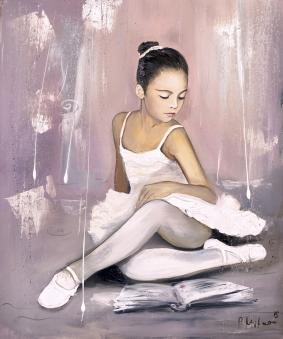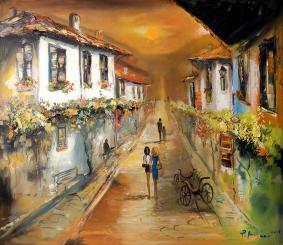Original artwork, 100 x 120 cm, Oil on canvas, 2014
The final part of Pavel Mitkov's ballet triptych is painted according to the best traditions of complex, multipart artworks. It has it all: a link back to the first and second parts, a summary, a persuasive conclusion and an end to the story. In an interesting twist, the triptych comes a full circle with a new level of interest that refers back to the beginning, prompting observes to have another look at and give another thought to the entire three-piece composition. Mitkov's tiny dancer is the same and yet different. She has gone from naïve childish dreams in the first part (blue butterflies of dreams) to schooling and studying in the second (the open “secret book”) and finally, the first experience on stage, evidenced by the focused professional manner she fixes the pointe shoes, and by a lovely snow-white rose at the bottom of the painting. The flower is a sign of the secret that the young character has at last grown up to discern, a sign of admiration, gratefulness and audience's sincere love. Where there is talent, there are admirers. Yet, the admirer of the young ballerina's talent, bestowing a single white rose, is not what one would call unsophisticated. Rather than a bunch of flowers or a fancy floral arrangement by a passionate master florist, it is just one divine flower, the Mount Everest Rose, inspired by the world's highest peak. The sharp snow-white petals symbolise eternal ice, snow and frosty cliffs where flocks of cold white clouds drowse. The rose stem and leaves are rid of the naïve spring greenery. Their black colour hints at the undiscovered, the hidden. This is a colour concealing feelings and thoughts. So, the gift is ambiguous, both a wish for achievement of top, sky-high excellence, and a grave warning: the way to the top is so demanding that passing a certain point, one cannot afford the luxury of morality. Those aspiring to perfection are so engulfed with themselves that they have no strength to think of or help others. This is what is known as the Everest law – the higher one gets, the less humanity is left. So, what has prompted the unknown bestower of the white rose to such reflections? Was it their own bitter experience? Doesn't the ballerina's round clear forehead seem indeed more and more unyielding? Aren't flashes of red, showing under the childish sweet pink, evidence of inner pressure, struggle and pursuit of power and success whatever the price? Away with doubts! What we see is a hard-working little dancer. How zealously (just as she has been taught) she puts her hands to her pointe shoes! She needs to “break in” the shoes, and then sew lace-ribbons, as well as sheathe the toes and the heels. Only in the course of movement, practice and hard work, will one shoe become right and the other – left. And the rose... For Christians, a white rose is the symbol of purity and chastity. Furthermore, a rose is the unofficial symbol of Bulgaria, where the divine flower has been grown industrially for ages. And then again, the young ballerina is rising above the rose, above the greatest vanity of all, above the temptation of fame and the mercurial adoration of wowed crowds. The tinkle of pure silver, the rhythmical chords of white, the serene attentiveness on the face of the little dancer, who is growing, developing and has already filled up the canvas, they all convey St Benedict's simple and fathomable motto “Ora et labora” (“pray and work”).
Ballet is comprised of emotions and form. It is a very sculptural kind of art. How thoroughly Pavel Mitkov knows the essence of ballet is clear when looking at all three pieces of his work together. What bell does the triptych ring? A splendid sculptural group of an elaborate fountain? Circular, clockwise movement following the sun. And every step develops, reveals the image, much like the bud of a lovely flower is blooming before our very eyes, filling up the canvas. The right foot, “kissed” by the blue butterfly of dreams in the first part, joins the left one, put into a pointe shoe, in the final part. On the whole, the girl's legs and feet in this triptych are like links of a jewellery piece created by a goldsmith's whimsical imagination. It is, indeed, a chain whose centre is pinpointed by the ballerina's body position in the second painting, where only one of her arms is well visible. The right and the left sides of the arrangement are highlighted by the right and left sides, respectively, of the open book lying in the centre. In all three pieces, the ballerina is portrayed sitting on the floor. In this pose of a tightened spring, there is a huge energy, emotional and creative potential accumulated. A fore-taste and admiration of the flight, exultation and victory in touching with one of the oldest forms of art – ballet – is what Pavel Mitkov's wonderful triptych gives us.









